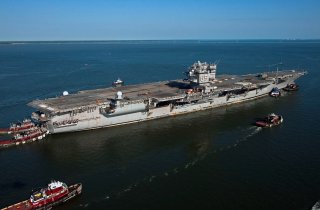Aircraft Carriers and Battleships Rule: These 5 Dominate the Seas
Aircraft carriers are still the dominant power projection platform of the U.S. and other navies.
HIJMS Zuikaku:
Zuikaku represented the zenith of pre-war Japanese carrier development. Along with her sister Shokaku, Zuikaku filled out Kido Butai with the addition of two large, fast, modern carriers. Displacing 32,000 tons and capable of carrying 72 aircraft, Zuikaku could make 34 knots, and absorb a relatively large amount of battle damage.
The size and modernity of the carriers meant that they could handle a greater operational tempo early in the war. After the Pearl Harbor raid, they participated in the Indian Ocean Raid, helping to sink the British carrier Hermes and several other ships. Afterward, Zuikaku and her sister deployed to Port Moresby to cover Japanese landings in what became the Battle of Coral Sea. Zuikaku survived undamaged, and contributed to the sinking of USS Lexington, but because of a lack of aircraft could not participate in the Battle of Midway.
Zuikaku continued to form the core of the Japanese carrier fleet into 1944, participating in and surviving the battles of Guadalcanal (where her aircraft helped sink USS Hornet) and the Battle of Philippine Sea. By October 1944, her supply of aircraft and pilots was almost completely exhausted. At the Battle of Leyte Gulf, Zuikaku and several other carriers served as bait for Halsey’s battleships and carriers, luring them away from the center of the Japanese attack. The last survivor of the Pearl Harbor attack, Zuikaku sank under a barrage of bombs and torpedoes.
USS Midway:
USS Midway entered service in September 1945, shortly after the end of hostilities against Japan. She displaced 45,000 tons, could make 33 knots, and could carry roughly 100 aircraft. Midway and her sisters represented a step beyond the Essex-class carriers that had won the Pacific War, and promised to introduce a new era of naval aviation.
Upon commissioning, Midway became the world’s most lethal aircraft carrier. The offensive power of her air group exceeded that of the Essex carriers then in service, and with the introduction of jet aircraft the gap would grow. With the A-2 Savage carrier-based bomber, Midway and her sisters briefly became the only carriers in the world capable of delivering nuclear weapons.
Midway underwent extensive modification over the course of her career, eventually acquiring an angled flight deck and other innovations. Although she missed Korea, Midway operated off Vietnam, and continued to serve as the larger “supercarriers” came online. She found heavy use in the Gulf War of 1990, as her (relative) small size gave her an advantage in maneuverability over the more modern supercarriers. Midway left service in 1992, having spanned the history of naval aviation from the F6F Hellcat to the F/A-18 Hornet.
USS Theodore Roosevelt:
The ten Nimitz-class nuclear aircraft carriers have been the world’s dominant capital ships since they began to enter service in the late 1970s. Constructed over a period spanning nearly 35 years, the class continues to provide the core of American naval power. Among the most active of the Nimitz class has been the USS Theodore Roosevelt, first of the second group of ships. Roosevelt entered service in 1986; she displaces over 100,000 tons, carries between 75-80 aircraft, and can make 30 knots top speed.
Roosevelt has served in most of the conflicts of the post Cold-War era. In 1991 she launched strikes against Iraqi targets during Operation Desert Storm. In 1999, her aircraft conducted strikes in Kosovo and Serbia in service of Operation Allied Force. After the September 11 attacks, Roosevelt deployed to the Middle East and participated in the first sorties against the Taliban and Al Qaeda in Operation Enduring Freedom. Two years later, her aircraft flew against Iraqi targets again in the first days of Operation Iraqi Freedom. After a refit, Roosevelt launched strikes against both Afghan and Iraqi targets in the latter part of the decade. Most recently, Roosevelt helped blockade Yemeni ports against a suspected Iranian arms convoy.
Like her sister ships, Roosevelt has already undergone substantial modification across the course of her thirty year career, and the Navy expects that these refits will continue into the future. Current projections suggest that she will leave service around 2035, which would give the carrier a nearly fifty-year span of lethality.
Wrap:
Pundits and analysts have predicted the obsolescence and demise of the aircraft carrier since the waning days of World War II. At the moment, however, the Russian, Indian, British, Chinese, French, and American navies continue to put faith, and resources, into carrier aviation. Despite the vulnerability of the big ships to attack, they provide a unique combination of presence, prestige, and lethality that continues to make them attractive to the world’s most powerful navies.
This piece first appeared in 2016. It is being republished due to reader interest.
Image: Flickr.

